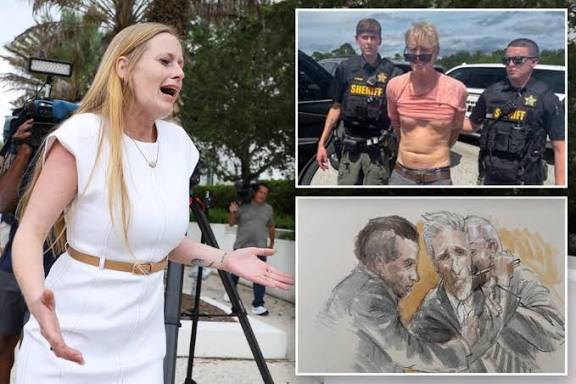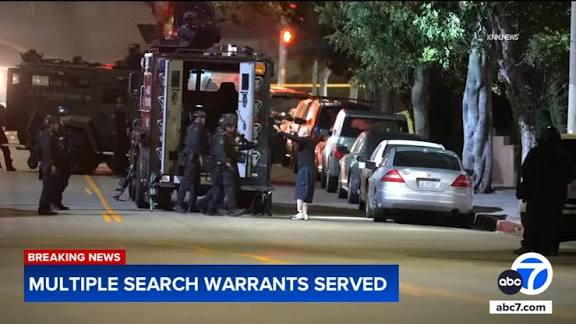Caught on Camera: Ryan Routh’s Daughter Loses It in Court

A decision was taken on Tuesday in the federal test of Ryan Wesley Routh, who was accused of attempting to kill President Donald. Today we will discuss about Caught on Camera: Ryan Routh’s Daughter Loses It in Court
Caught on Camera: Ryan Routh’s Daughter Loses It in Court
In a moment of high drama, video footage from a federal courtroom in Florida captured a visceral outburst by Sara Routh, daughter of Ryan Wesley Routh, immediately after a jury returned a guilty verdict in his attempt to assassinate Donald Trump. That outburst, caught on camera and replayed by media outlets, has become a defining image in the aftermath of a trial already marked by tension, legal theatrics, and emotional extremes.
This article unpacks the context, the courtroom moment, the fallout, and the broader significance of that emotional breakdown — both for the Routh family and for public perception of this case.
Background: Who Is Ryan Routh?

To understand the dramatic courtroom scene, it is essential to know who Ryan Wesley Routh is and what charges he faced.
-
On September 15, 2024, Routh positioned himself in shrubbery near the Trump National golf course in West Palm Beach, Florida, armed with a rifle, with the apparent intention of targeting the then-candidate Donald Trump.
-
A Secret Service agent noticed suspicious movement, fired a warning shot or shot at Routh’s position, and Routh fled the scene.
-
He was arrested on a nearby interstate and eventually charged with multiple counts: attempted assassination of a presidential candidate, assaulting a federal officer, possession of a firearm in furtherance of a crime of violence, possession of a firearm as a convicted felon, and possessing a firearm with an obliterated serial number.
-
At trial, Routh elected to represent himself, despite no formal legal training.
-
The jury deliberated for roughly two hours before returning a guilty verdict on all counts.
The case was already steeped in legal complexity and spectacle before the courtroom breakdown, but the moment of emotional collapse would add a human, raw dimension to a case otherwise dominated by legal and political narratives.
The Courtroom Moment: Breakdown in Real Time
The focal point of the drama came when the verdict was read. Video footage and reporting reconstruct the sequence:
-
Verdict Read, Tension Rises
As the jury’s decision was announced, the courtroom grew tense. Routh, seated in the defendant’s chair, appeared to react physically. -
Self-Harm Attempt
Immediately following the verdict, Routh grabbed a pen — a type that, in custody settings, is often designed to be flexible to reduce harm — and attempted to stab himself in the neck. He was quickly restrained by U.S. Marshals.
According to witnesses, the pen left only bruising, and no life-threatening injuries were reported. -
Daughter’s Outburst
From the gallery, Sara Routh leapt to her feet. She began shouting desperately:“Dad, I love you. Don’t do anything. I will get you out.”
“He didn’t hurt anybody. This is not fair. This is all rigged — you guys are a-holes.”
“Get the f- out of my face.”Her spontaneous emotional eruption became the visual and emotional centerpiece of post-trial coverage.
-
Removal and Return
Marshals escorted the distraught Routh out of the courtroom. After the tension cleared, he was brought back in shackles to hear the remainder of proceedings. -
Outside the Courtroom
As Routh was led away in a black SUV, Sara chased after it, screaming “I love you.”
Her brother, Adam Routh, attempted to calm her and steer her away from reporters, but the media scrum intensified.
The footage quickly went viral. In courtroom reporting, this emotional outbreak became more than an addendum — it became a lens through which many viewed the entire case.
What Explains the Emotional Collapse?
In high-stakes trials, moments of emotional overload are rare but understandable. Several factors may help explain Sara Routh’s breakdown:
-
Parental Devotion: Regardless of the charges, for a daughter witnessing her father under extreme distress, the instinct to protect may override decorum.
-
Perceived Injustice: Sara’s statements reflect a belief that the trial was unfair or “rigged.” In her mind (or in reports of what she shouted), she viewed the verdict as a betrayal, not just of him, but of the judicial process.
-
Traumatic Shock: The abruptness of the self-harm attempt added shock and urgency. Her reaction may have been less rational speech and more instinctive panic.
-
Media Pressure and Cameras: Knowing she was on camera may have amplified her emotional intensity, though it’s unclear whether she was fully aware of recording devices during her outburst.
-
Psychological Stress: Over the course of the trial, as evidence mounted against her father and stakes escalated, the emotional burden likely grew. The verdict’s confirmation may have been a breaking point.
While no one outside the Routh family can fully map Sara’s internal state, what we saw was a powerful human moment — raw, flawed, tragic — that exposed the human stakes behind headlines and legal briefs.
Aftermath: Media, Public Reaction & Implications
The outburst rippled far beyond the courtroom:
-
Media Amplification
News organizations across the spectrum broadcast the moment repeatedly. Clips with captions such as “caught on camera,” “breakdown in court,” and “daughter loses composure” framed Sara’s reaction as spectacle — and made it a focal point rather than a footnote. -
Sympathy and Criticism
Some viewers expressed empathy, seeing Sara’s behavior as understandable in the circumstances. Others criticized it as melodramatic, legally inappropriate, or even disrespectful to court decorum. -
Narrative Framing
The moment shifted public perception. For some, Sara became a face of the human damage wrought by high-stakes politics and extreme ideation. For others, she was a spectacle. Media coverage sometimes risked overshadowing the legal substance of the trial by focusing on the emotional drama. -
Legal & Procedural Questions
The self-harm attempt raised questions about courtroom security, protocols for pen access for defendants in custody, and mental health screening. The fact that the pen was of the “noninjurious” type didn’t prevent the attempt. -
Impact on Sentencing Atmosphere
While judges are supposed to remain impartial, such dramatic episodes—especially when emotionally resonant—can influence the broader atmosphere of a case. The courtroom became more emotionally marked, not just legally contested. -
Broader Themes
The scene underscored how criminal cases, especially ones involving political violence, are not just about statutes and evidence — they are also about human fragility, familial devotion, psychological stress, and public theater.
Putting It in Context: Political Violence Trials & Family Fallout
The Routh trial occupies a particularly charged niche: the intersection of political violence and personal tragedy. Compared to other high-profile cases:
-
In trials involving terrorism or political plots, courts often guard rigorously against emotional displays to protect the dignity and focus of proceedings.
-
But those same trials frequently generate powerful emotional fallout, especially among family members who may feel torn between public condemnation and private loyalty.
-
The Routh case is unusual in that the emotional reaction was not a silent tear or a single word, but a sustained, vocal collapse. That intensity magnified media coverage and narrative framing.
In that sense, Sara’s breakdown is not just a human reaction — it becomes part of the public record, a defining image in how people will remember this case.
What the Footage Says About Our Media Age
The phrase “caught on camera” carries both fascination and condemnation in modern journalism. Some reflections:
-
Visual Immediacy
The emotional moment is more powerful because it was captured live. A still photo might be memorable, but a video amplifies the sense of immediacy and human chaos. -
Viral Dynamics
Cameras in courtrooms (where allowed), livestreams, and public access have turned many courtroom moments into media events. Outbursts, gavel bangs, dramatic cross-examinations — these become content as much as evidence. -
Editorial Choices
Editors decide which moment to highlight: the emotional breakdown, the self-harm attempt, legal arguments, or victim statements. The choice to foreground Sara’s outburst reflects both the power of the moment and the media’s preference for human drama. -
Ethical Tension
Broadcasting emotional distress raises ethical questions: Are we exploiting someone’s breakdown for clicks? Where is the line between news and spectacle? In Sara’s case, even as she was victimized by the situation, her vulnerability was transformed into a public performance. -
Memory and Legacy
It is likely that many people will remember Sara’s scream and tears more vividly than the legal arguments or even the verdict itself. That memory becomes part of the case’s legacy.
What Comes Next: Penalties, Appeals, and Family Strains
While the emotional breakdown has captured headlines, the legal and familial consequences are still unfolding.
-
Sentencing Date
Routh is scheduled to be sentenced on December 18, 2025, and faces a possible life sentence for the severity and multiplicity of counts. -
Appeals
Given the high stakes and potential procedural debates, an appeal is virtually guaranteed. Sara’s courtroom breakdown itself is unlikely to serve as a legal basis for reversal, but may factor into arguments about courtroom procedure, fairness, or emotional climate. -
Family Impact
The relationship between Sara, her brother Adam, and their father will likely be forever altered — psychologically, publicly, and privately. Sara’s very public emotional collapse may also expose her to both support and criticism in public discourse. -
Security & Courtroom Protocols
The incident could trigger changes in how pens or writing implements are handled in courtrooms, especially in politically sensitive or high-stakes trials. It also may prompt mental health considerations for defendants during verdict readings.
Lessons & Reflections
-
Humanity in High-Stakes Legal Drama
Legal cases can become abstract battles of evidence and precedent. The human dimension — the emotional cost, the family loyalty, the human limit — often remains hidden until moments like this break through. -
Media’s Power to Define Memory
The moment that is caught, replayed, shared, and captioned becomes the memory anchor. That can overshadow nuance, but it can also bring attention to what is at stake beneath the legal shell. -
Emotional Breakdowns Are Not Just Weakness
We often expect composed arguments in court. But when the pressure, stakes, and emotion converge, breakdowns can be inevitable. In public trials, they become part of how the case is told and remembered. -
Navigating Sympathy, Judgment & Complexity
Audiences must balance the impulse to judge or condemn with a recognition of trauma, stress, and familial complexity. The father is accused of an extreme crime; the daughter’s reaction doesn’t absolve or indict — it humanizes. -
Courtroom Design for Emotional Safety
Judges, marshals, and court staff may need to consider how to integrate psychological safeguards into a setting built for logic and procedure — especially in trials involving violence, radical ideation, or political issues.
Conclusion
The image of Sara Routh screaming, tears flowing, rushing toward a father she believes is unjustly condemned — that image, caught on camera, will remain one of the indelible visuals from this trial. It crystallizes the collision of legal drama and raw humanity in a way that legal briefs never can.
That moment does not change the facts on which Routh is guilty, nor does it erase the seriousness of the charges. But it forces observers to remember: behind every headline, every trial, every verdict, there are human lives — tangled, emotional, fragile.
How useful was this post?
Click on a star to rate it!
Average rating 0 / 5. Vote count: 0
No votes so far! Be the first to rate this post.
About the Author
usa5911.com
Administrator
Hi, I’m Gurdeep Singh, a professional content writer from India with over 3 years of experience in the field. I specialize in covering U.S. politics, delivering timely and engaging content tailored specifically for an American audience. Along with my dedicated team, we track and report on all the latest political trends, news, and in-depth analysis shaping the United States today. Our goal is to provide clear, factual, and compelling content that keeps readers informed and engaged with the ever-changing political landscape.




